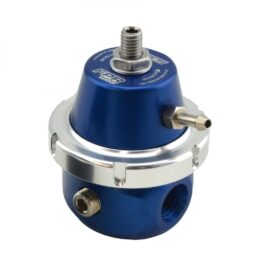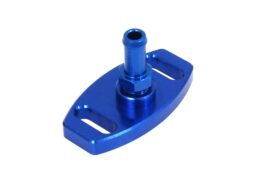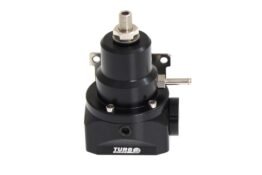Aprašymas
Turbosmart’s newest High-performance EFI fuel pressure regulator is smaller, lighter and better! Now featuring two AN10 inlet ports, one AN8 return port and 1/8″ gauge port, 30-60 PSI base pressure adjustment, 1:1 ratio, premium diaphragm and stainless steel valve + seat allow for ANY fuel type including E85 and is suitable for engines with up to 3000hp fuel systems. FPR’s feature a non-directional bias to regulation, so no matter where the fuel comes in they will regulate the same. Factory tested.
Supplied With: Mounting bracket and retaining clip, vacuum fitting and gauge port blank.
- EFI fuel regulator
- 2 x AN10 ports and 1 x AN8 port
- 1/8″ NPT Gauge port
- Capable of regulating up to 1200hp of fuel flow
- 1:1 manifold pressure ratio with no load losses
- 30-60psi base pressure range
- Stainless steel internals providing maximum integrity and reliability
- Suitable for all fuel types
- Operational between -35ºC to +200ºC
- MILSPEC diaphragm
- Manufactured, assembled and validated in-house at Turbosmart HQ
WHY BUY A TURBOSMART FPR?
All Turbosmart FPRs are CNC machined in house from billet aluminium + stainless steel and hand-assembled and tested to ensure maximum precision. Turbosmart FPR’s have been designed to provide smooth and stable fuel pressure delivery under all conditions from idle to full throttle and are suitable for use with both electric and mechanical fuel pumps. The FPR range features an easy screw and lock adjustment and provide a stable 1:1 ratio between fuel pressure and manifold pressure. Each FPR is backed by a variety of accessories such as fuel rail adapters, gauges and fittings to suit most popular makes and models.
WHAT IS A FUEL PRESSURE REGULATOR?
A fuel pressure regulator’s job is to maintain constant fuel pressure above the intake manifold pressure.
WHEN DO YOU NEED TO INSTALL ONE?
The installation of performance fuel injectors or a high-flow fuel pump requires the use of an aftermarket fuel pressure regulator to allow pressure adjustments while maintaining a stable base pressure. They can also be used to maximise a standard fuel system’s ability to cope with minor power modifications.

















